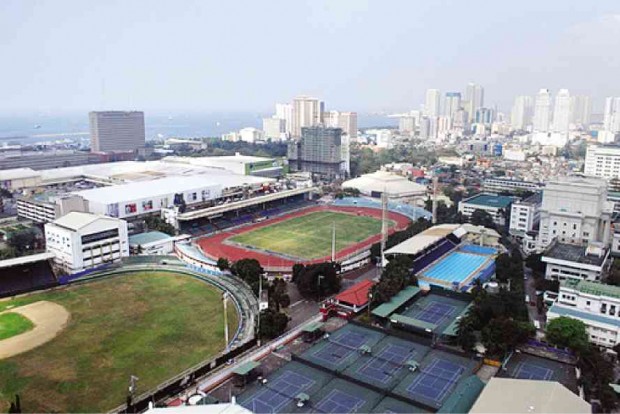Razing a monument
The story is told that when the legendary home run king Babe Ruth stepped up to the plate of Rizal Memorial Baseball Stadium on the sun-baked afternoon of Dec. 2, 1934, the locomotive roar of fans still had not ebbed a bit.
Lou Gehrig had earlier blasted the first-ever homer at the new stadium, sending the Filipino fans, who accorded the visiting American Major League All Stars team a welcome fit for kings, into raptures.
“The Babe” let the first pitch fly past him, winked at hurler Reginio Portucion and then sent the second fastball of the National University ace rocketing well beyond the ballpark’s right field wall 303 feet away. Before crossing homeplate, Ruth faced Portucion, bowed at him and said “Thank you!”
Shell-shocked, the Philippine Olympic team lost, 9-1, to the celebrated Americans, who nevertheless marvelled at the Filipinos’ passion for the game and the grand stadium’s “beautiful architecture.”
Now dust-covered and in a serious state of disrepair, the ballpark along with the nearby Rizal Memorial Coliseum, the 25,000-seat track and field stadium, the Ninoy Aquino Stadium, the Olympic-sized pool, as well as the complex’s satellite facilities—all repositories of unforgettable sporting memories from yesteryear—face the big wrecking ball, if a billionaire businessman will have his way.
Port magnate Enrique Razon wants to transform the entire 10-hectare Rizal Memorial Sports Complex (RMSC) into a mall and mixed-use property development, in support of the City of Manila’s urban renewal program.
While the Manila city government owns the property, the Philippine Sports Commission (PSC) manages the 82-year-old complex for the national government. And here’s the rub: The property—donated by the city for the construction of the sports complex used for the 1934 Far Eastern Games Championships—cannot be sold to anyone without the consent of both Manila and the PSC which have crossed swords in the past over ownership of the complex.
Negotiations for the property’s possible sale are ongoing between the Manila city government and Razon’s group.
PSC Chair William “Butch” Ramirez believes that the transfer of ownership will take time but is inevitable as the commission is planning to relocate to Clark Field in Pampanga where it is planning to build a national sports training center.
“Once the PSC and Manila agree [on ownership], the sports center will be constructed with the approval of President Duterte,’’ says Ramirez. “The Office of the President, through Executive Secretary Salvador Medialdea, wants to make sure the transaction [sale of the property] is proper and legal.”
The PSC chief says they will initially seek the opinion of the Department of Justice on the status of the property. Barring any more legal challenges, the commission and the city government will sit down for negotiations. “It’s a long process, but we’re already looking at a new location for the training center and to house the national athletes,’’ says Ramirez. “The transfer from RMSC will take up to a year because of the negotiations.”
The RMSC also hosts dormitories for athletes who, according to the PSC, will have to be moved temporarily to the government-owned Philsports complex in Pasig.
The Bases Conversion and Development Authority has allocated 100 hectares in Clark’s Green City in Pampanga to house the new training center. The government will fund the construction of the facilities and the road network within the complex.
Apart from the redevelopment of the RMSC, the Razon group promises to keep the old façade of the complex intact and build a sports museum to remind visitors of the history of the complex. Open green spaces will be allocated in the commercial areas, which will be run by smart-technology firms.
With this urban renewal project, the Razon group expects Manila to quickly catch up with neighboring cities that have grown and modernized. The project will also create thousands of jobs for residents while providing a steady revenue stream for the city government.
But the exterior appearance isn’t the only concern, says Ramirez. History and culture advocates have suggested that the art-deco coliseum, ballpark and main stadium be spared from the transformation. These facilities were rebuilt years after World War II, when the Japanese occupation army garrisoned Manila and transformed the sports complex into a vital defensive outpost that was later bombed and left in ruins by American tank shells and bombs. Less than 10 years later the country celebrated the com plex’s renovation by staging the 1954 Asian Games there.
Through the years the easy accessibility of the complex has been a magnet for a variety of events and historic moments. Who can forget the frenzied arrival in the stadium of the Beatles in the 1960s and the blockbuster gig of rock star Jon Bon Jovi in the 1990s.
Apart from Gehrig and Ruth, whose first two home runs are immortalized in bold letters on the far wall of the ballpark, Korean basketball sharpshooter Shin Dong-pa, football star David Beckham and Brazilian football hero Cruzeiro dazzled Filipino fans with their sublime moves in the complex’s hallow grounds.
The sports complex has been a silent witness and a constant reminder of the country’s rich sporting past. Sadly, though, everything will turn into dust the moment the developers get their hands on this monument to Filipino athleticism and start it tearing down.
